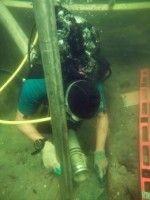Complete and utter darkness surrounds her. Postdoctoral student Jessi Halligan might as well be swimming through tar as she attempts to navigate the cold darkness of the Aucilla River in Florida.
Halligan is attempting what may seem to be a daunting task excavating fossil evidence of 14,000-year-old early humans.
Halligan collaborated with A&M anthropology professor Michael Waters and other researchers at the Universitys Center for the Studies of First Americans in a search for archaeological evidence to suggest that early men crossed over into the Americas more than 1,000 years earlier than was previously thought.
Similar expeditions were conducted by the Florida Museum of Natural History at the same site 25 years before Halligans team, but no concrete evidence was recovered from these earlier expeditions.
Basically we were going out there to see if we can find anything in that older layer, Halligan said.
Waters said that the most commonly accepted theory regarding the first groups of early man a group of prehistoric people called the Clovis arrived in the Americas about 13,500 years ago. Waters, Halligan and the other researchers are looking for archeological evidence to prove that an earlier culture may have arrived around 2,500 years earlier.
Halligan said previous digs around the Aucilla River were questionable because the area was an underwater dig site.
Its a really big deal that they found this, but it was found at a time when scientists were absolutely positive that there was nothing here besides Clovis, Halligan said. So basically everybody said Its an underwater site, they just messed up while digging it.
Matthew Renfro, sophomore history major, said this research is good for academia because it challenges ideas previously accepted by the scientific community.
I think one major [lesson] would be never to accept what you believe is true to be completely for certain, Renfro said. Here at A&M, we do question we always question and make sure we can confirm what weve heard or give good basis for believing that.
Halligan excavates the underwater fossils in full scuba gear and digs the fossils through layers of debris with a pinpoint laser, while using flashlights to penetrate the Florida waters. Underwater sites like these provide archeologists with superior preservation not found in above-ground dig sites.
Everywhere that is dry in North America has a lot of artifacts from that time period, but all you have left is stone because of the preservation, Halligan said. Where I am working, some of that stuff is 14,000-year-old grape skins literally the skins of grapes that were popped. Thats unheard of amazing preservation, which means if we do find evidence of people living down there, well probably have almost everything they left behind.
At this point, the expedition has found remains of mastodons and other fossilized animals of the period, but the human artifacts the team has been searching for have not yet been uncovered.
There have been questions raised about if the artifacts they found 25 years ago were definitely coming from that older deposit, Waters said. So we wanted to back and excavate the area to see if we could duplicate what was found 25 years ago.
The Clovis people were hunter-gatherers who used stone tools distinctive to their people. If Waters and his team could find early human artifacts that are different than these tools, the evidence could help to disprove this model.
If we find an unambiguous artifact down there, or something that was definitely made by people, we can reconfirm what the earlier people said: it is definitely a site that is more than a 1,000 years older than Clovis, Halligan said.
Waters and his team have additionally gathered evidence across the U.S. that further supports this idea and that may end up revising the dominant Clovis model.
It does take a long time to kind of revise that model, Waters said. We have to figure out how these early people fit into what is Clovis. Theres going to be some resistance, but eventually as data accumulates from one site at a time, you have to stand up and take note that these arent anomalies people were here before Clovis.
Researchers seek evidence of earlier human presence
February 26, 2013

Donate to The Battalion
Your donation will support the student journalists of Texas A&M University - College Station. Your contribution will allow us to purchase equipment and cover our annual website hosting costs.



















